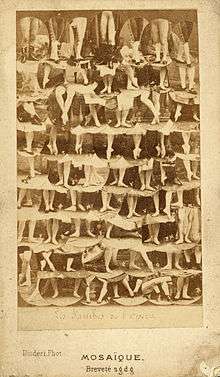André-Adolphe-Eugène Disdéri
| André-Adolphe-Eugène Disdéri | |
|---|---|
 Self-portrait, c. 1860 (Paris, musée d'Orsay) | |
| Born |
28 March 1819 Paris |
| Died |
4 October 1889 Paris |
| Nationality | French |
| Occupation | Photographer |
| Years active | 1846–1870 |
| Known for | Photographic career as a daguerreotypist |
| Signature | |
_-_Marchio_di_fabbrica.jpg) | |
André-Adolphe-Eugène Disdéri (28 March 1819 – 4 October 1889) was a French photographer who started his photographic career as a daguerreotypist but gained greater fame for patenting his version of the carte de visite, a small photographic image which was mounted on a card. Disdéri, a brilliant showman,[1] made this system of mass-production portraiture world famous.
Early life
Disdéri began his working life in a number of occupations, while also studying art.[2] He started as a daguerreotypist in Brest in 1848 or 1849 but in December 1852 or January 1853 he moved to Nîmes. There he received assistance from Édouard Boyer and Joseph Jean Pierre Laurent with his photography-related chemistry experiments.<ref "mccauley_1985">McCauley, Elizabeth Anne (1985). A. A. E. Disdéri and the Carte de Visite Portrait Photograph. Yale University Press. pp. 14–15,231.</ref>[3][4] After a year in Nîmes he moved to Paris, enabling easy access to people who would be the subjects of his cartes de visite.
Disdéri and the carte de visite

Photographs had previously served as calling cards,[5] but Disdéri's invention of the paper carte de visite (i.e. "visiting card") photograph second enabled the mass production of photographs. On 27 November 1854 he patented the system of printing ten photographs on a single sheet (although there is no evidence that a system printing more than eight actually materialized).[6] This was the first patent ever for a carte de visite. Disdéri's's cartes de visite were 6×9 cm, about the size of conventional (nonphotographic) visiting cards of the time, and were made by a camera with four lenses and a sliding plate holder; a design inspired by the stereoscopic cameras.[7]
The novelty quickly spread throughout the world. According to a German visitor, Disdéri's studio became "really the Temple of Photography - a place unique in its luxury and elegance. Daily he sells three to four thousand francs worth of portraits".[8]
The fact that these photos could be reproduced inexpensively and in great quantity brought about the decline of the daguerreotype and ushered in a carte de visite craze as they became enormously popular throughout Europe and the United States.[9][10] So great was the publicity that all of Paris wanted portraits.
Disdéri also invented the twin-lens reflex camera.[9]
The great French photographer Nadar, who was Disdéri's competitor, wrote about the new invention in his autobiographical "Quand j'étais photographe", "about the appearance of Disdéri and Carte de Visite... It spelled disaster. Either you had to succumb - that is to say, follow the trend - or resign."[11]
Later years and death
At the pinnacle of his career, Disdéri was extremely wealthy and renowned; but like another famous photographer, Mathew Brady, he is reported to have died in near poverty.[9]
By the end of his life, Disdéri had become penniless. He died on 4 October 1889 in the Hôpital Ste. Anne in Paris, "an institution for indigents, alcoholics, and the mentally ill".[12] He was a victim of his own invention. The system which he invented and popularized was so easy to imitate that photographers all over the world took advantage of it.
Notes
- ↑ "André Adolphe-Eugène Disdéri" at the Getty.
- ↑ Wilder, who names the occupations as "commerce, acting and politics".
- ↑ Disdéri (1853). Manuel opératoire de photographie sur collodion instantané. Paris. p. 7.
J'ajouterai un mot pour remercier M. Boyer, pharmacien, et surtout M. Laurent, chimiste et contrôleur de garantie à Nimes, pour les renseignemens [sic] que ce dernier eût la bonté de me fournir au sujet de la partie chimique de cet ouvrage...
- ↑ Disdéri (1853-09-24). "Correspondance". La Lumière (39): 156.
C'est alors que, de concert avec M. Laurent, amateur distingué de cette ville, nous fîmes quelques expériences...
- ↑ Wilder.
- ↑ Date according to Wilder. Provision of ten images in the patent according to McCauley. An eight-image example from 1858 is displayed in metmuseum.org
- ↑ McCauley.
- ↑ Liesegang, E. Geschichte der Firma Ed. Liesegand, page 8 (1929).
- 1 2 3 Leggat, Robert. "Disdéri, Andre Adolphe Eugene". mpritchard.com.
- ↑ "A History of Photography: From its beginnings till the 1920s".
- ↑ Nadar. Quand j'étais photographe, ISBN 2742717978
- ↑ Elizabeth Anne McCauley, A.A.E. Disdéri and the Carte de Visite Portrait Photograph, Yale University Press, 1985.
Sources
- McCauley, Elizabeth Anne. "Carte de visite." Oxford Companion to the Photograph, ed. Robin Lenman. Oxford: Oxford University Press, 2005. ISBN 0-19-866271-8.
- Wilder, Kelley E. "Disdéri, André-Adolphe-Eugène." Oxford Companion to the Photograph, ed. Robin Lenman. Oxford: Oxford University Press, 2005. ISBN 0-19-866271-8.
External links
| Wikimedia Commons has media related to André Adolphe Eugène Disderi. |
- npg.org
- getty.edu
- metmuseum.org
- Encyclopaedia Britannica, Andre-Adolphe-Eugene Disdéri. Accessed 28 November 2007.
- The virtual Cabinet Card museum.
- Works by Disdéri Collection Paul Frecker, London.
Archives
- 19th Century Actors Carte de Visite Collection. 1860-1885. 605 photographic prints on carte de visite mounts ; 4 x 2½ in. At University of Washington Libraries, Special Collections.
